Intro
In the Middle Ages, a trader specializing in the type of oriental goods (pepper, nuts, cinnamon, oil...) was a rich man. With the development of large-scale commerce, the fortune and power of the “bourgeois traders” continued to grow. Indeed, during the late Middle Ages, the small regional associations of craftsmen and merchants with common interests evolved and prospered until they became powerful European leagues. We will deal in this article:
- Communications
- Commercial activity in the Middle Ages
- Navigation
The communication channels
New trade routes
The Europeans slowly began to emancipate themselves towards the external territories. Thanks to the Crusades, they now moved confidently over land and sea. The map of medieval trade routes shows that great trade touched all of Europe:
- In the north, a powerful association of Germanic and Scandinavian cities, the Hansa, exercised a veritable monopoly in the North Sea and the Baltic.
- To the south, the port cities of Genoa, Amalfi, and Venice, Italy, dominated Mediterranean trade. These cities benefited from the consequences of the crusades which contributed powerfully to reactivating trade with the ports of the Levant.
In addition, caravan trails and sea routes reached India, Southeast Asia and China. Products from these countries were bought by Europeans in the cities of the Levant or in Byzantium. In exchange, they sold wood, iron, wheat, wine, oil, etc.
Spanish caravan
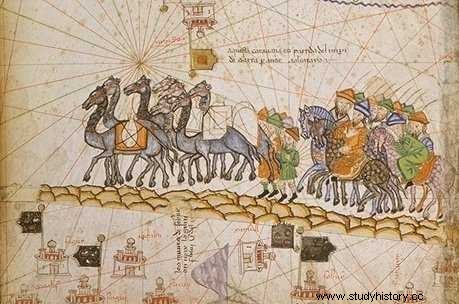
Caravan crossing the Silk Road (National Library of France)
Technical innovations
Among the causes of the rise of medieval trade, we must count certain technical progress made in the field of means of transport. For land transport, there are the advances of shoeing, harnessing and coupling to the line of horses. These innovations were supplemented by the iron strapping of the wheels of carts and chariots as well as the increase in paved roads. Other improvements occurred later:in the 14th century, the straps suspending the boxes of the carts and the limbers turning around an axle appeared.
The Roman network
From Rome, as a "nerve centre", many roads and roads radiated out following routes that could reach any point in the Empire, including the most distant, and along which travelers could benefit from a remarkable system relays for horses and inns to rest. During the fall of the Roman Empire, the change which took place, if it was not brutal, nevertheless followed a slow process of deterioration and abandonment which will last for more than two centuries. Concretely, from the reign of Emperor Caracalla until the third century of our era, Rome had ceased to concern itself with the maintenance of the secondary network of roads; only the main roads that started from Rome benefited from these vital tasks, the relays worked, and the inns, although becoming rare, remained open. The immense network of communication routes developed by the Romans, one of the most colossal works of civil engineering of all time, was unfortunately to disappear with the collapse of the Empire.
The Pont du Gard, a 1st century Roman aqueduct
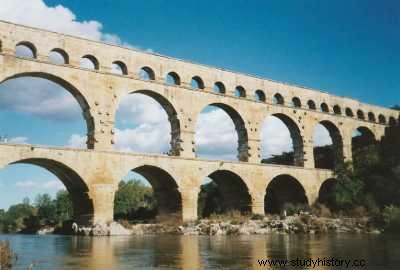
The ways of invasion
In the 7th century AD, the great Roman roads, already badly deteriorated, nevertheless remained the best and busiest means of communication of the time. These were the Roman roads that many barbarian tribes took in priority to invade the Empire from the 4th century, with their heavy carts drawn by oxen, cattle and slaves, not to mention the women, children and formidable mounted warriors. on horseback. According to the chronicles of the time, in Europe and in the first half of the 8th century, these roads or what remained of them were abandoned in favor of strictly local roads. Towns, cities and entire villages then experienced mass desertification. This period coincides with the beginning of feudalism.
The “Little Renaissance”
In the second half of the 8th century on the Old Continent there was a revival of commercial, intellectual and religious activity initiated by the Emperor Charlemagne, a dominant personality of the High Middle Ages (period extending from the beginning of the 5th century until at the dawn of the twelfth century). The Carolingian Empire, maintained by the successors of Charlemagne was to last almost a century and a half during which it experienced an authentic renaissance which asserted itself in the first half of the 9th century. The roads of Europe during these long periods were once again busy. But that was the end of the ancient Roman roads; time had done its work on the one hand, and, after the successive passage of barbarians and peasants, they had been ransacked and plundered, because the material of which these ways were made, blocks of stones of excellent quality had been revealed very useful for the construction of dwellings. Many mansions were built from stone quarried from Roman roads. All these reasons meant that very little remained of the wide roads that once crossed the mountains and crossed the rivers on ingenious bridges, most of which have been destroyed. The paths and paths of the Carolingian Empire, if they were inspired by the Roman road, were much more modest.
Map of Western Europe
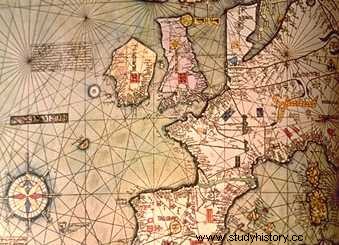
Feudalism:location of trade
Feudalism had made timid appearances in the first half of the 8th century, now it reappears with all its vigor at the beginning of the 10th century. At that time, the feudal system of vassalage predominated in Germany, England and much of France. Rigid system in which the peasant, serf of the soil, had to bend to the yoke of the land. At the top reigned the great feudal lords, owners of immense territories and to which other less wealthy owners, the vassals, had to submit. Feudalism is a very local system which is almost independent of the exterior. The lords ensure the protection of the vassals because the roads are no longer very safe. As a result, the tenth century was the darkest period in European history. The paths were emptied of their travellers, only the troops of soldiers traversed them, during the inevitable warlike incursions. The abandoned cities and towns then looked like ghosts of stone. Rome which, a century before our era, had hosted half a million people, according to the least optimistic calculations, in the tenth century did not count more than fifty thousand souls, subjected to all kinds of acts of violence and humiliations from a greedy nobility.
Roads at the service of pilgrimages
Despite everything, from the middle of the 11th century, commercial activity began to give signs of life. The road to Santiago, which led to the borders of northeastern Spain, where according to legend the remains of the apostle James the Greater, became the busiest road in Europe. Pilgrims leaving France crossed the Pyrenees to go and pray at the tomb of the holy apostle. The way to Compostela or "French way" was effectively guarded by the famous military order of the Templars, and its knights had the mission of clearing the way of looters and criminals, highwaymen and tricksters of all stripes who haunted it. . In fact, this zeal was sometimes confused with a few excesses, to such an extent that on two occasions the Pope had to put a brake on the excessive fervor of certain knights. In addition to the pilgrims, who usually traveled on foot and in small groups, many other travelers in transit took the French route:showmen, actors, itinerant strollers, promiscuous women, tooth-pullers, barbers, drapers, merchants in wine, wood merchants, water sellers, sellers of relics (all certainly false); all manner of priests and friars, members of minor orders such as mendicant friars.
Commercial activity in the Middle Ages
Trade in the Middle Ages
The Middle Ages are divided into two major stages:
- The High Middle Ages :It extends from the 5th century to the middle of the 11th century. It is a chaotic time where the depopulation of towns and cities is increasing. Eminently rural period during which the trading system was based on barter.
- The Late Middle Ages :This period will see trade and merchants flourish, thus was to be born a form of capitalism which will assert itself over time. The Guilds and the hanses come from this second part of the Middle Ages. Originally, these were brotherhoods of a religious nature, which flourished during the Carolingian Empire, which gave birth to corporations.
Shopping street in the Middle Ages
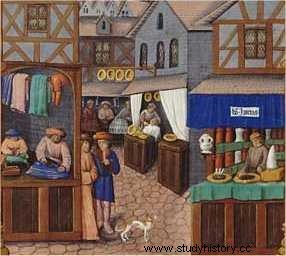
From brotherhoods to leagues
Despite a respectable ideology “a traditionally pious and charitable association placed under the protection of a patron saint”, some of the brotherhoods attracted numerous criticisms for their disorderly life. In 852, Hincmar, Archbishop of Reims, harshly criticized the customs of groups capable of transforming feasts of sanctification to the glory of God into the most sumptuous banquets. It then became difficult to distinguish brotherhoods and corporations, religion and profession being then closely united. Despite a so-called Carolingian renaissance, Europe remained a rural society where towns and cities counted for little. From the economic boom of the end of the tenth century, towns and cities began to count in the still dispersed environment of rural society, and craftsmen grouped together by field of activity:haberdashers, goldsmiths, merchants of water, drapers, grocers, painters, musicians... The corporations defended the interests of their members and also served the municipal authorities to control the quality of products and set taxes. Merchants will play a leading role during the 11th century. Trade is growing:goods are transported from one point in Europe to another by land or along the Mediterranean coast. The risks incurred throughout the transport were multiple:banditry, outrageous tolls, etc. The need to protect mutual interests was therefore essential and the merchants would join together in guilds:from the city, the exchange then extended to the country and very quickly to the regions, announcing prosperity.
Guilds and guilds
The guilds had their own privileges and jurisdictions codified according to an officially recognized statute. Among these were the fixing of prices, that of weights and measures and the commercial monopoly. Some guilds obtained the right to mint their own coins, but these cases were however rare and short-lived. In the context of the time, the guild passed for being an authentic association of merchants and transporters on the same waterway, of customers drawn from the same commercial center. The Merchants Guild of Tiel, in Gelderland, for example, was in contact with England, it is the oldest. The brotherhood was that of the Lower Hall of Valenciennes, in France, whose archives date from 1050. Then appeared the Merchant Guild of Saint Omer. But it was Flanders and the Rhine regions that were the spearhead of the economic guilds which, much later around the 18th century, would spread to England, to all of the Netherlands, to the Scandinavian countries...
The Ommeganck festival in Brussels
Procession of trades. Note the emblems corresponding to the different brotherhoods.

The Ommeganck Festival in Brussels, by Denis van Alsloot (Prado Museum, Madrid)
Hanses of Europe
The guilds had vigorously contributed to the development of the communal movement by arousing the spirit of solidarity and resistance to the feudal regime. But these corporations will soon disappear to make way for a more ambitious policy, first regional then European:the creation of the hanses (from the old German hansa , troop, band). First of all grouping of guilds, the hanses did not escape the movement and were transformed into leagues of merchant cities:
- The Hanse of London brought together more than twenty cities and towns around trade with the British capital.
- The Hanse des XVII Villes, an association of cloth merchants, which became established in 1230 in the Netherlands and in the north of France.
- The Teutonic Hansa, undoubtedly the most famous and important of all. In the 14th century, it was at its peak. Against the domination of this patriciate, oligarchic and exclusive, the little ones leagued together. Its power was such that states treated its representatives as ambassadors of a great country.
Hanseatic trade was based, on the one hand, on the traffic in furs and wax, coming from Russia and Prussia, on the other hand, on that of Flemish and English cloth and rock salt. To these basic products were added copper and iron from Sweden, wines from France or the Rhine, etc. In the 15th century the decadence of the guilds and hanses became manifest, with the exception of the Teutonic Hansa. Many of them returned to the concept of religious brotherhood, the rites of which were to be maintained until a late period (in the middle of the 19th century, in England).
Major fairs
If the largest part of international trade came from the ports of the North or the Mediterranean, these then irrigated the entire continent. Now traders were real businessmen, whereas their predecessors moved around on mules or rickety carts, they now bought whole shiploads and lots of goods. At the fairs, where these great merchants met, huge deals were settled. Fairs were the soul of medieval commerce. They took place all over Europe:London, Reims, Troyes, Cologne, Leipzig, Geneva... The fairs each lasted six or seven weeks according to a fixed schedule so that the fairs could be linked together in relation to the others. Thus, the market was active all year round. The deals concluded during these meetings encouraged industrial and artisanal production, they stimulated technical progress. In order to prevent large merchants from transporting a large quantity of money, the bill of exchange was invented. :this means makes it possible to pay a debt at a distance, via the intermediary of two bankers who correspond with each other. The bill of exchange introduced credit, but in a camouflaged way because the Church forbade loans with interest. During this period, wealthy Italian families were at the forefront of banking. The world was changing, feudal castles were losing their importance while trading towns grew. The fortune of the lords dwindled to the benefit of the wealthy bourgeois who held the reins of the economy. This contributed to the birth of modern states.
Merchant Fair
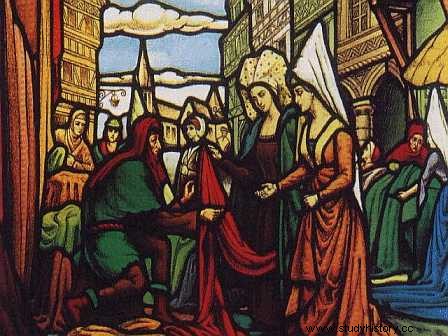
Browsing
Technical advances in navigation
The great medieval trade benefited from the progress made in the construction of ships and in the appearance of new instruments of navigation. The most important innovation was the diffusion of the compass . Its origin remains uncertain:if the Chinese had known it for a long time, it was perhaps the Arabs who introduced it to Europe, unless it was rediscovered by Western sailors or astronomers. The magnetic needle which simply floated, at the beginning, on water or on oil was, thereafter, fixed on a pivot making it possible to turn the compass in all the directions. Sailors could now face the high seas without fear of going off course. In addition to the compass, two Arab instruments began to be used, the astrolabe and the sextant , which made it possible to measure the height of the stars above the horizon. By calculating exactly the time spent sailing, one could accurately determine the distance the ship had traveled to the north or south (latitude), to the east or west (longitude). Taking advantage of these improvements, the Genoese were the first at the end of the 13th century to link Italy to Flanders and England by sea. At that time the typical ship was the galeasse . This galley moved mainly under sail. The appearance of the triangular lateen sail, which could be oriented in all directions, allowed the ship to sail in crosswinds and even against the wind. The stern rudder, fixed by hinges in the middle of the rear deck of the ship (stern rudder), replaced the side oars, long and heavy, the maneuvers were improved. The yard (cross support of the sail) rotating allowed to direct the square sails to the side wind. On some sailboats, a second mast at the front was beginning to appear.
The Galeass
To navigate, Italian, French or Catalan sailors used the galleass. The length of the ship was three times its width, and the latter twice its height, this is the Catalan rule (tres dos ya as, "three, two, one"). In the Baltic Sea, the hourque was used instead, the hull of which was made of planks overlapped and not joined.
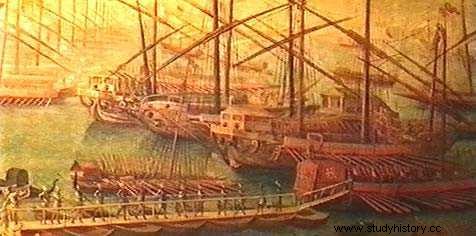
Commercial shipping
As we have already seen, the fall of the Roman Empire caused the collapse of the communication routes. Trade by sea during the Holy Roman Empire was considerable. The provinces of the Empire did not stop exchanging their goods, the Mediterranean was then swept by the great quinqueremes and triremes. Thus the wheat of Egypt was used to supply the port of Ostia which allowed the survival of Rome. Around the year 250, the manufacture of large triremes ceased, and navigation was no longer current. Barbary pirates, Sicilian and Maltese corsairs then occupied the Mediterranean. So much so that at the appearance of the Vikings on the European coasts, no power could compete on the sea. Thereafter, Genoese and Venetians made a fierce fight to dominate in the Mediterranean. The Portuguese, for their part, after the invention of the caravel, were more prey to the quest for new lands and distant markets. The spice trade was a Portuguese monopoly for a long time. This small coastal country on the Iberian Peninsula had become the richest kingdom in Europe. This then gives an idea of the importance of commercial shipping. We are then in the middle of the 15th century and the Middle Ages are coming to an end.
